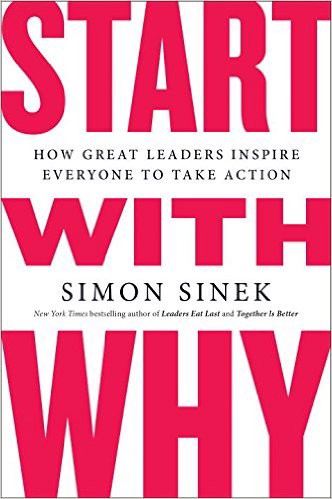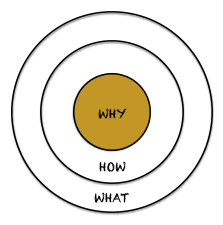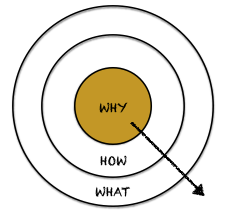
There are very few leaders, products, or companies that create movements. Very few leaders that inspire loyalty, not just a single transaction. Very few leaders that motivate their followers and employees to stick with them through thick or thin.
Think of leaders like Martin Luther King Jr. Or companies like Apple, Southwest Airlines, or Harley Davidson. These leaders and companies started movements. They have incredibly loyal followers and customers.
What is it that separates them from the rest? It?s that these leaders, products, and companies start with WHY.
In his book Start With Why, Simon Sinek explains why this approach works, and how every aspiring leader can incorporate it. As Simon mentions throughout his book:
?People don?t buy WHAT you do; they buy WHY you do it.?
The Golden Circle
Simon provides a useful framework for his approach to leadership: the Golden Circle. At the center of the Golden Circle is WHY. The next concentric circle is HOW. And finally, the outermost circle is WHAT.
 The Golden Circle: Why, How, What
The Golden Circle: Why, How, What
Every leader and company knows the WHAT. They can describe their products, their industry, and their competitors. Some companies also know HOW they do WHAT they do ? their unique differentiators, their value proposition, and their values. But few companies know or articulate their WHY ? their purpose, their cause or their belief. The WHY is their reason for being. And the WHY is why anyone should care.
Since the WHAT is the easiest to know and articulate, most leaders and companies start with WHAT. Sometimes they will also discuss HOW, but they rarely talk about WHY. With respect to the Golden Circle, they go outside-in.
Simon advocates that we should invert the order. Go from the inside-out in the Golden Circle. Start with WHY, discuss the HOW, and end with WHAT.
 The right way to inspire is to communicate inside-out
The right way to inspire is to communicate inside-out
As Simon writes:
?When most organizations or people think, act or communicate they do so from the outside in, from WHAT to WHY. And for good reason???they go from clearest thing to the fuzziest thing. We say WHAT we do, we sometimes say HOW we do it, but we rarely say WHY we do WHAT we do.?
?When communicating from the inside out, however, the WHY is offered as the reason to buy and the WHATs serve as the tangible proof of that belief.?
Apple starts with why
A good example that Simon discusses is Apple. Is Apple a computer company? A consumer electronics company? A smartphone company? These are all expressions of WHAT. If Apple only identified itself with the WHAT, you might rightly ask, ?What the heck is Apple doing in all of these disparate industries??
But Apple doesn?t start with WHAT. They start with WHY. In the early 2000s, Apple started a campaign to communicate the WHY called ?Think Different.?
Throughout its history, Apple has been a challenger, a disruptor, an innovator. With the Apple computer, they did this with the computer industry in the ?70s and ?80s. With iTunes and the iPod, they did it again with the music industry in the early 2000s. And with the iPhone, they did it again with the mobile phone industry in 2007. Each time, they stayed true to their WHY: ?Think different.?
Millions and millions of consumers identify with the WHY. It?s why every single iPhone release is an industry phenomenon. It?s why customers camp out overnight and line up around the block for hours to get their hands on the newest iPhone. It?s why customers are willing to pay premium prices, even when cheaper Android alternatives exist. As Simon reminds us throughout the book:
?People don?t buy WHAT you do; they buy WHY you do it.?
In the case of Apple, they?re buying the WHY of ?Think Different.? Of challenging the status quo, of being an innovator.
As Simon writes:
?We want to be around people and organizations who are like us and share our beliefs. When companies talk about WHAT they do and how advanced their products are, they may have appeal, but they do not necessarily represent something to which we want to belong. But when a company clearly communicates their WHY, what they believe, and we believe what they believe, then we will sometimes go to extraordinary lengths to include those products or brands in our lives.?
Starting with WHY gives your followers and customers a way to identify with you on a personal level. If your WHY matches their WHY, they are willing to stand with you through thick and thin. Without a clear WHY, people default to the WHAT. Then you are always caught in this struggle to differentiate yourself in the sea of WHAT. And you are forced to differentiate yourself with features, or worse, with price. Simon describes this well below:
?Products with a clear sense of WHY give people a way to tell the outside world who they are and what they believe. Remember, people don?t buy WHAT you do, they buy WHY you do it. If a company does not have a clear sense of WHY then it is impossible for the outside world to perceive anything more than WHAT the company does. And when that happens, manipulations that rely on pushing price, features, service or quality become the primary currency of differentiation.?
WHY, HOW, and WHAT must all be in harmony
To build trust with your followers and customers, you need authenticity. What does that mean in practice? It means that your HOW (actions) and WHAT (results) have to be consistent with your WHY (beliefs). They all need to work together in harmony. People can detect inconsistencies, and when they do, you are perceived as inauthentic and you erode trust.
In order to create harmony between WHY, HOW, and WHAT, you need:
- Clarity of WHY
- Discipline of HOW
- Consistency of WHAT
Clarity of WHY
You need to know your own WHY and be able to articulate that WHY in simple, clear terms. For Apple, it?s ?Think different.? For Southwest Airlines, its to be the champion for the common man and to make air travel accessible to all. Bob Iger, CEO of Disney, boils down their WHY to, ?We?re in the business of telling stories.?
As Simon writes:
?You have to know WHY you do WHAT you do. If people don?t buy WHAT you do, they buy WHY you do it, so it follows that if you don?t know WHY you do WHAT you do, how will anyone else? If the leader of the organization can?t clearly articulate WHY the organization exists in terms beyond its products or services, then how does he expect the employees to know WHY to come to work??
Discipline of HOW
Once you know and crisply articulate the WHY, you need the discipline to act in ways that support your purpose. This is where HOW comes in. The HOWs are the values and principles that guide your actions and decisions on a day-to-day basis. They are the true differentiators of your product or service.
As Simon writes, the discipline of HOW can be more difficult than the WHY:
?Ironically, the most important question with the most elusive answer ? WHY do you do what you do? ? is actually quite simple and efficient to discover? It?s the discipline to never veer from your cause, to hold yourself accountable to HOW you do things; that?s the hardest part.?
Consistency of WHAT
Finally, WHAT you do brings your WHY to life. A WHY is your core belief. HOWs are the actions and decisions you take to support the WHY. The WHAT is everything you produce. WHAT includes your products and services, but also your ?marketing, PR, culture and whom you hire.?
It is critically important that WHAT you produce is consistent with WHY and HOW. The WHAT is the tangible proof that people see, and the WHAT needs to be reinforced over and over again to build trust. As Simon writes:
?If people don?t buy WHAT you do but WHY you do it, then all these things must be consistent. With consistency people will see and hear, without a shadow of a doubt, what you believe. After all, we live in a tangible world. The only way people will know what you believe is by the things you say and do, and if you?re not consistent in the things you say and do, no one will know what you believe. It is at the WHAT level that authenticity happens.?
Applying ?Start with Why?
The principle of ?Start with Why? can have powerful benefits in everything we do. In a sales discussion with a new customer, we can start with WHY to help customers self-select as to whether they believe in our cause. If they do, they will buy into WHY we do it rather than WHAT we do, which can set the stage for them to become a loyal customer. As a result, they will be willing to pay a premium, put up with the occasional hiccup, and be resistant to the manipulations of our competitors.
When recruiting, if we ?Start with Why,? we can help potential employees self-select as to whether they believe in our cause. If they do, they will buy into WHY we do WHAT we do. In a startup, this belief in the WHY???the purpose???will sustain the employees through the inevitable ups and downs. When the company makes a major pivot, the employees will stand with them through thick and thin because they believe in the WHY. And when other companies come calling with solely extrinsic manipulations of better salary and title, these employees will think twice about exploring those other opportunities.
We can also use ?Start with Why? as our compass for decision-making. When pursuing anything new and innovative, there are so many unknowns. Despite that, there are plenty of people who will tell you what to do, sometimes with a smug over-confidence. ?It?s so obvious?? you should just do X. How can you be so dense not to see that?? If you know your WHY, you can quickly and safely reject any HOW or WHAT suggestions that are inconsistent with the WHY.
This last point is especially important for PMs and entrepreneurs. You need to be able to focus. Steve Jobs once said, ?Innovation is saying no to 1,000 things.? If you start with WHY, you know your purpose. You can only do those few, important things that are consistent with your purpose. And you can say ?no? to the many feature ideas that you hear for your customers, employees, and advisors that are inconsistent with your WHY.
You can also avoid the trap of focusing too much on your competitors and blindly copying whatever features they introduce. What they?re doing may work for them, but if it?s inconsistent with your WHY, it just doesn?t make sense to pursue. And more often than not, what your competitors are doing is likely to be inconsistent with your WHY.
As Simon writes:
?Companies that study their competitors in hopes of adding the features and benefits that will make their products ?better? are only working to entrench the company in WHAT it does. Companies with a clear sense of WHY tend to ignore their competition, whereas those with a fuzzy sense of WHY are obsessed with what others are doing.?
As entrepreneurs, product managers, and leaders, we often depend on others for support. We can?t bring about transformative change on our own. We clearly need the help of others.
To earn true employee and customer loyalty, you have to start with WHY. Most people start with WHAT because it?s the easiest thing to communicate. Then they may discuss the HOW, but rarely the WHY.
In order to inspire, invert the order. Start with WHY (purpose), then HOW (values and actions and differentiators), and then WHAT (products and results). To communicate authentically, you need to keep WHY, HOW, and WHAT in harmony. People only see the tangible evidence (WHAT), and if that is inconsistent with what you say your WHY is, you appear inauthentic.
It?s not enough to just communicate the WHY once. As Simon writes:
?A company, indeed any organization, must work actively to remind everyone WHY the company exists. WHY it was founded in the first place. What it believes. They need to hold everyone in the company accountable to the values and guiding principles.?
So, if you?re starting a company, start with WHY. If you?re building a new product, start with WHY. If you?re leading a team or an organization, start with WHY. Remember that ?People don?t buy WHAT you do; they buy WHY you do it.? The most effective leaders always win the heart first, and then the mind. And the only chance you have to win the heart if you start with WHY.

